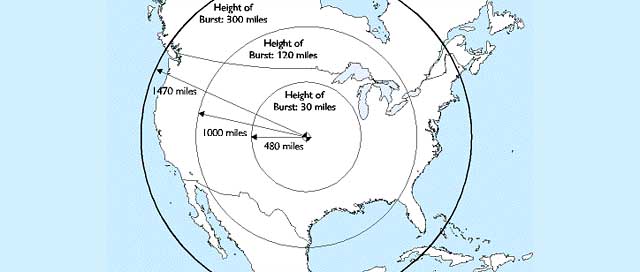Definition of an EMP
electromagnetic pulse (EMP):
The electromagnetic radiation from a nuclear explosion or a suddenly fluctuating magnetic field. The resulting electric and magnetic fields may couple with electrical/electronic systems to produce damaging current and voltage surges.
A broadband, high-intensity, short-duration burst of electromagnetic energy.
In the case of a nuclear detonation, the electromagnetic pulse consists of a continuous frequency spectrum. Most of the energy is distributed throughout the lower frequencies between 3 Hz and 30 kHz.
An instantaneous, intense energy field that can overload or disrupt at a distance numerous electrical systems and high technology microcircuits, which are especially sensitive to power surges.
A large scale EMP effect can be produced by a single nuclear explosion detonated high in the atmosphere. A similar, smaller-scale EMP effect can be created using non-nuclear devices with powerful batteries or reactive chemicals. Several nations, including reported sponsors of terrorism, may currently have a capability to use EMP as a weapon for cyber warfare or cyber terrorism to disrupt communications and other parts of the U.S. critical infrastructure.
The most important mechanism for Electromagnetic Pulse (EMP) production from a nuclear detonation is the ionization of air molecules by gamma rays generated from the explosion. These gamma rays ionize the air molecules by interacting with the air molecules to produce positive ions and recoil electrons called Compton electrons. This pulse of energy, which produces a powerful electromagnetic field, particularly within the vicinity of the weapon burst, is called an electromagnetic pulse. EMP can also be produced from non-nuclear sources, such as electromagnetic bombs, or E-bombs.
High-altitude nuclear detonations and electromagnetic bombs can generate EMP that has the potential to damage or destroy electronic devices over widespread areas. Electric power systems would also be at risk from surges produced by such weapons.
A 1.4 Megaton bomb launched about 250 miles above Kansas would destroy most of the electronics that were not protected in the entire Continental United States.
During the brief return to atmospheric testing in 1962, a 1.4 megaton nuclear weapon was detonated over Johnston Island at an altitude of about 250 miles. The effects of EMP were observed in Hawaii, 800 miles east of the detonation. Streetlights and fuses failed on Oahu and telephone service was disrupted on the Island of Kauai.
EMP is not radioactive, but a pulse of energy produced as a side effect of a nuclear detonation or electromagnetic bomb.
EMP has no known effect on living organisms, but can temporarily or permanently disable electrical and electronic equipment.
A big enough EMP will induce currents in semiconductor components and fry them.
Instead of simply cutting off power in an area, an EMP would actually destroy most machines that use electricity. Generators would be useless, cars wouldn’t run, and there would be no chance of making a phone call. In a matter of seconds, a big enough EMP could thrust an entire city back 200 years.
If you enjoyed this, or topics of current events risk awareness or survival preparedness,
check out our current homepage articles…

